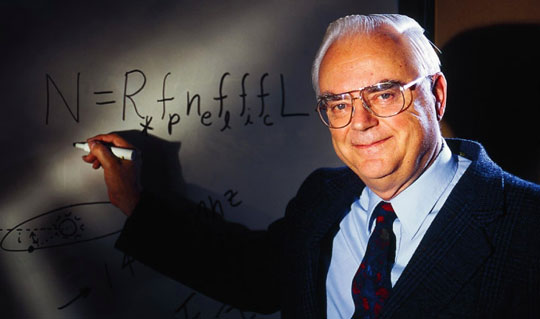Education

-- Frank Drake, 1961

Where,
N = The number of civilizations in The Milky Way Galaxy whose electromagnetic emissions are detectable.
R* = The rate of formation of stars suitable for the development of intelligent life.
fp = The fraction of those stars with planetary systems.
ne = The number of planets, per solar system, with an environment suitable for life.
fl = The fraction of suitable planets on which life actually appears.
fi = The fraction of life bearing planets on which intelligent life emerges.
fc = The fraction of civilizations that develop a technology that releases detectable signs of their existence into space.
L = The length of time such civilizations release detectable signals into space.
Within the limits of our existing technology, any practical search for distant intelligent life must necessarily be a search for some manifestation of a distant technology. In each of its last four decadal reviews, the National Research Council has emphasized the relevance and importance of searching for evidence of the electromagnetic signature of distant civilizations.
Besides illuminating the factors involved in such a search, the Drake Equation is a simple, effective tool for stimulating intellectual curiosity about the universe around us, for helping us to understand that life as we know it is the end product of a natural, cosmic evolution, and for making us realize how much we are a part of that universe. A key goal of the SETI Institute is to further high quality research that will yield additional information related to any of the factors of this fascinating equation.
- About Artificial Intelligence(al)
Artificial intelligence (AI) is the intelligence exhibited by machines or software. It is also the name of the academic field of study which studies how to create computers and computer software that are capable of intelligent behavior. Major AI researchers...
- What Is Black Hole?
Black holes are some of the strangest and most fascinating objects found in outer space. They are objects of extreme density, with such strong gravitational attraction that even light cannot escape from their grasp if it comes near enough. Albert Einstein...
- Are Aliens Trying To Contact Us?
In the 1997 film "Contact," which was an adaptation of a novel written by Carl Sagan, an astrophysicist played by Jodie Foster becomes the first human to make contact with an extraterrestrial civilization after detecting a strong, patterned radio signal...
- The Evolution Of Life On Earth
The stage was set for earth’s birth much, much earlier, at the origin of all things – the Big Bang – about 13.7 billion years ago. Modern scientists estimate that the earth is 5 to 6 billion years old. By comparison, most of the evolution of human...
- Darwin And His Theory
Charles Darwin was born on 12 February 1809, the fifth of six children. His grandfather Erasmus Darwin was a physician and poet with fascinating for natural philosophy. The poet known depictions of the natural world and the speculation about the nature...
Education
The Drake Equation

"What do we need to know about to discover life in space?"
How can we estimate the number of technological civilizations that might exist among the stars? While working as a radio astronomer at the National Radio Astronomy Observatory in Green Bank, West Virginia, Dr. Frank Drake conceived an approach to bound the terms involved in estimating the number of technological civilizations that may exist in our galaxy. The Drake Equation, as it has become known, was first presented by Drake in 1961 and identifies specific factors thought to play a role in the development of such civilizations. Although there is no unique solution to this equation, it is a generally accepted tool used by the scientific community to examine these factors.-- Frank Drake, 1961

Where,
N = The number of civilizations in The Milky Way Galaxy whose electromagnetic emissions are detectable.
R* = The rate of formation of stars suitable for the development of intelligent life.
fp = The fraction of those stars with planetary systems.
ne = The number of planets, per solar system, with an environment suitable for life.
fl = The fraction of suitable planets on which life actually appears.
fi = The fraction of life bearing planets on which intelligent life emerges.
fc = The fraction of civilizations that develop a technology that releases detectable signs of their existence into space.
L = The length of time such civilizations release detectable signals into space.
Within the limits of our existing technology, any practical search for distant intelligent life must necessarily be a search for some manifestation of a distant technology. In each of its last four decadal reviews, the National Research Council has emphasized the relevance and importance of searching for evidence of the electromagnetic signature of distant civilizations.
Besides illuminating the factors involved in such a search, the Drake Equation is a simple, effective tool for stimulating intellectual curiosity about the universe around us, for helping us to understand that life as we know it is the end product of a natural, cosmic evolution, and for making us realize how much we are a part of that universe. A key goal of the SETI Institute is to further high quality research that will yield additional information related to any of the factors of this fascinating equation.
- About Artificial Intelligence(al)
Artificial intelligence (AI) is the intelligence exhibited by machines or software. It is also the name of the academic field of study which studies how to create computers and computer software that are capable of intelligent behavior. Major AI researchers...
- What Is Black Hole?
Black holes are some of the strangest and most fascinating objects found in outer space. They are objects of extreme density, with such strong gravitational attraction that even light cannot escape from their grasp if it comes near enough. Albert Einstein...
- Are Aliens Trying To Contact Us?
In the 1997 film "Contact," which was an adaptation of a novel written by Carl Sagan, an astrophysicist played by Jodie Foster becomes the first human to make contact with an extraterrestrial civilization after detecting a strong, patterned radio signal...
- The Evolution Of Life On Earth
The stage was set for earth’s birth much, much earlier, at the origin of all things – the Big Bang – about 13.7 billion years ago. Modern scientists estimate that the earth is 5 to 6 billion years old. By comparison, most of the evolution of human...
- Darwin And His Theory
Charles Darwin was born on 12 February 1809, the fifth of six children. His grandfather Erasmus Darwin was a physician and poet with fascinating for natural philosophy. The poet known depictions of the natural world and the speculation about the nature...
